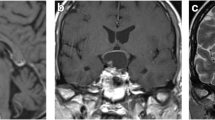Summary.
Summary.
Background and Purpose:
In clinically non-functional pituitary macroadenomas, prospective follow-up magnetic resonance imaging (MRI) was conducted after transsphenoidal surgery both to study the changes of the sellar contents at the post-operative site over time and to assess the amount of residual adenoma tissue.
Methods:
A total of 50 patients with clinically non-functional pituitary macroadenomas were treated by transsphenoidal tumour resection and were examined by MRI before and directly after surgery (early MR) and 3 months (intermediate MR) and 1 year after surgery (late MR). Changes in the sellar contents over time and the degree of tumour excision were studied on T1-weighted enhanced and unenhanced scans. All patients underwent complete neuro-ophthalmological and endocrinological assessments before and 3 months after surgery. For the interpretation of the post-operative images the results of the endocrinological examinations after surgery were also taken into account.
Results:
The maximum size of tumour extension on coronal T1-weighted images ranged from 1.2 cm to 5.0 cm (mean 2.3 cm). Despite tumour resection, early post-operative images still showed a persistent mass in the sella in 83% that was usually caused by post-operative haemorrhage, fluid collection and implanted fat material. However, rapid improvement in visual symptoms was noted in 89%. Changes in the sellar region at the early post-operative site markedly hindered the interpretation of MR images for detecting residual tumour tissue, which was suspected in half of the patients (1 intrasellar, 13 suprasellar, and 11 parasellar). Regression of the post-operative mass in the sella was present 3 months after surgery, resulting in a 50% change in the volume of the coronal sellar extension, which also improved the reliability in interpreting the post-operative MR images. On the intermediate MR images residual tumour tissue was detected in 30% of the patients (4 intrasellar, 2 suprasellar and 9 parasellar). Because the suprasellar mass descended over time, an increasing rate of tumour remnant within the sella was seen 3 months following surgery. Before surgery the pituitary gland was visible superiorly or posterosuperiorly to the macroadenomas in 35 patients. However, at the early post-operative site the remaining gland was only visible in 12 patients. Under the condition that endocrinological function tests confirmed adequate hormonal function, the remaining gland was detectable by MRI in 36 patients 3 months after surgery.
Conclusion:
Delayed regression of the sellar contents after transsphenoidal surgery of pituitary macroadenomas was demonstrated by this prospective MR study. Owing to the changes at the post-operative site, it was difficult to interpret early post-operative images and detect residual adenoma tissue. With respect to the delayed regression of the sellar contents, the interpretation of post-operative images for detection of residual adenoma was improved 3 months after surgery. At this time, residual adenoma tissue was found in 30% of clinically non-functional macroadenomas, mostly at the parasellar and, after descent from the suprasellar space, at the intrasellar site.
Similar content being viewed by others
Author information
Authors and Affiliations
Rights and permissions
About this article
Cite this article
Kremer, P., Forsting, M., Ranaei, G. et al. Magnetic Resonance Imaging after Transsphenoidal Surgery of Clinically Non-Functional Pituitary Macroadenomas and its Impact on Detecting Residual Adenoma. Acta Neurochir (Wien) 144, 433–443 (2002). https://doi.org/10.1007/s007010200064
Issue Date:
DOI: https://doi.org/10.1007/s007010200064




